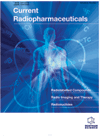- Home
- A-Z Publications
- Current Radiopharmaceuticals
- Previous Issues
- Volume 12, Issue 3, 2019
Current Radiopharmaceuticals - Volume 12, Issue 3, 2019
Volume 12, Issue 3, 2019
-
-
New 99mTc Radiotracers for Myocardial Perfusion Imaging by SPECT
More LessAuthors: Wei Fang and Shuang LiuObjective: Myocardial Perfusion Imaging (MPI) with radiotracers is an integral component in evaluation of the patients with known or suspected coronary artery diseases (CAD). 99mTc-Sestamibi and 99mTc-Tetrofosmin are commercial radiopharmaceuticals for MPI by single photon-emission computed tomography (SPECT). Despite their widespread clinical applications, they do not meet the requirements of an ideal perfusion i Read More
-
-
-
Pre-feasibility Study for Establishing Radioisotope and Radiopharmaceutical Production Facilities in Developing Countries
More LessBackground: A significant number of developing countries have no facilities to produce medical radioisotopes and radiopharmaceuticals. Objective: In this paper we show that access to life-saving radioisotopes and radiopharmaceuticals and the geographical distribution of corresponding infrastructure is highly unbalanced worldwide. Methods: We discuss the main issues which need to be addressed in order to establish the Read More
-
-
-
O-(2-[18F]-Fluoroethyl)-L-Tyrosine (FET) in Neurooncology: A Review of Experimental Results
More LessAuthors: Carina Stegmayr, Antje Willuweit, Philipp Lohmann and Karl-Josef LangenIn recent years, PET using radiolabelled amino acids has gained considerable interest as an additional tool besides MRI to improve the diagnosis of cerebral gliomas and brain metastases. A very successful tracer in this field is O-(2-[18F]fluoroethyl)-L-tyrosine (FET) which in recent years has replaced short-lived tracers such as [11C]-methyl-L-methionine in many neuro-oncological centers in Western Europe. FET can be produ Read More
-
-
-
The Screening of Renoprotective Agents by 99mTc-DMSA: A Review of Preclinical Studies
More LessAuthors: Masoud Rezaei, Maryam Papie, Mohsen Cheki, Luigi Mansi, Sean Kitson and Amirhossein AhmadiBackground: Nephrotoxicity is a prevalent consequence of cancer treatment using radiotherapy and chemotherapy or their combination. There are two methods; histological and biochemical, to assess the kidney damage caused by toxic agents in animal studies. Although these methods are used for the try-out of renoprotective factors, these methods are invasive and time-consuming, and also, lack the necessary sensitivity f Read More
-
-
-
Comparison Between 18F-Dopa and 18F-Fet PET/CT in Patients with Suspicious Recurrent High Grade Glioma: A Literature Review and Our Experience
More LessPurposes: The aims of the present study were to: 1- critically assess the utility of L-3,4- dihydroxy-6-18Ffluoro-phenyl-alanine (18F-DOPA) and O-(2-18F-fluoroethyl)-L-tyrosine (18F-FET) Positron Emission Tomography (PET)/Computed Tomography (CT) in patients with high grade glioma (HGG) and 2- describe the results of 18F-DOPA and 18F-FET PET/CT in a case series of patients with recurrent HGG. Methods: We searched for studi Read More
-
-
-
Feasibility and Evaluation of Automated Methods for Radiolabeling of Radiopharmaceutical Kits with Gallium-68
More LessObjectives: Recent gallium-68 labeled peptides are of increasing interest in PET imaging in nuclear medicine. Somakit TOC® is a radiopharmaceutical kit registered in the European Union for the preparation of [68Ga]Ga-DOTA-TOC used for the diagnosis of neuroendocrine tumors. Development of a labeling process using a synthesizer is particularly interesting for the quality and reproducibility of the final pr Read More
-
-
-
68Ga/64Cu PSMA Bio-Distribution in Prostate Cancer Patients: Potential Pitfalls for Different Tracers
More LessBackground: 68Ga-PSMA is a widely useful PET/CT tracer for prostate cancer imaging. Being a transmembrane protein acting as a glutamate carboxypeptidase enzyme, PSMA is highly expressed in prostate cancer cells. PSMA can also be labeled with 64Cu, offering a longer half-life and different resolution imaging. Several studies documented bio-distribution and pitfalls of 68Ga-PSMA as well as of 64Cu- PSMA. No data ar Read More
-
-
-
Evaluation of the Radioprotective Effects of Melatonin Against Ionizing Radiation-Induced Muscle Tissue Injury
More LessBackground: Radiotherapy (RT) is a treatment method for cancer using ionizing radiation (IR). The interaction between IR with tissues produces free radicals that cause biological damages.As the largest organ in the human body, the skeletal muscles may be affected by detrimental effects of ionizing radiation. To eliminate these side effects, we used melatonin, a major product secreted by the pineal gland in mammals, as a ra Read More
-
Volumes & issues
Most Read This Month
Article
content/journals/crp
Journal
10
5
false
en


